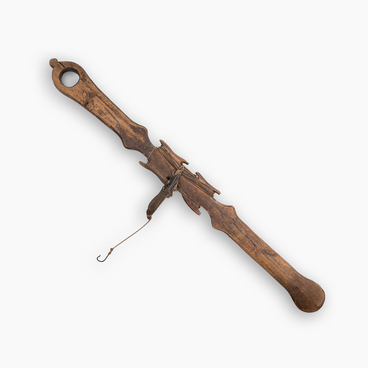The boat presented in the museum was made by the inhabitants of the village of Lovozero. It was used as a transport and fishing boat. It is a handmade product made of pine boards and fastened at the joints with nails and wire. It has two pairs of oars, which are fixed to the sides with the help of rowlocks.
The Sami people, both of Scandinavian and Kola ethnic groups, used lightweight boats. Dried reindeer sinew was traditionally used as a material for stitching seams, while fresh wood roots could also be used.
In the early 20th century, saws and planers were also used to cut wood and shave boards. The bottom of the boat was hollowed out from a solid tree trunk. From the outside it was shaped like a keel. The edges of the bottom were made to have the same thickness as the sides and then they were tightly laid on the first, lower boards of the side, which together with the keel formed a rather flat bottom of the boat from the inside. Staples were usually placed on the outside of the keel. At the point of joining the first and second planks of the side, a steep bend was made. The edge of the bottom board was placed on the inside of the thinning edge of the second board, and then both boards were sewn together.
The rope that fastened the boards was threaded through holes drilled in the edges and laid in a groove hollowed out between them. The seam ended approximately at the point where the upward curve of the board began. Here the ends of the ropes were cut off and fixed with wooden pegs.
The planks were nailed together at the bow and stern. The nails could be wooden or metal. In the same way, the second board was joined to the third one and so on. Each board usually consisted of three longitudinal boards.
From the inside, the boat was fastened together with five spandrels — cross ribs that were nailed to the planks with wooden nails. Seams and other holes were covered with moss and tarred.
The advantages of such light boats were their
relatively high carrying capacity, rather rare cases of capsizing, and
protection from water penetration thanks to their high sides.





